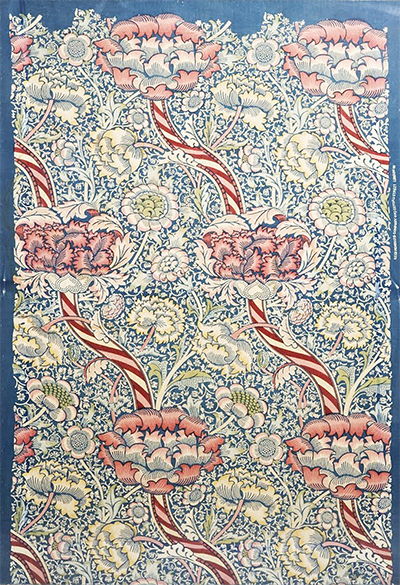The snaking flower stems within Wandle would represent the river which passed through Surrey's Merton Abbey Works, which is where the artist produced much of his work. Soft water from the river would be used within the textile process, adding to this river's significance.
Many variants of the original design can be found today, where the colour tones were alternated to produce different results. One example of Wandle can be found in the V&A Museum in London, UK and this furnishing fabric was produced using blue tones alongside white. Another version to be found in the Museo Nacional de Artes Decorativas in Madrid, Spain, incorporated the same blue background but with the foreground pattern appearing in pink, green and red for a more impactful finish. Wandle was designed in 1883 before being patented a year later. Research has suggested that the actual manufacture of this design did not commence until some years later, perhaps between 1910 and 1917. The design is highly memorable because of the diagonal stems which in some versions were striped with different colours - these thick lines snaked through the artwork, just as the river would have done through the Surrey landscape. Morris was always looking to connect nature to themes in his work, and the role of this river's water in his production process made its inclusion all the more inevitable. Aside from the river's path, we also find many flower heads within this piece, of differing sizes.
Most likely, the V&A version is in a single blue tone because it comes from early in the process, before the other colours were added. It therefore gives us a glimpse into the transitionary state at which the artwork was constructed. Morris would spend most of his life studying different techniques and this enabled him to broaden the company's product list. He was a curious man who loved to understand more about traditional artistic techniques and would also look for inspiration elsewhere in the world, besides just the UK. India gave him many ideas about printed cotton, for example, and how dyes from natural sources would ultimately deliver better results. He was joined within the company by a number of other notable artists who would bring their own specialisations to the firm, and between them they could cover pretty much any interior design request. Some notable patrons would come to their door, offering some prestigious commissions and they were seen as specialists in quality, for those who could afford to pay a little extra.
Morris left behind a strong legacy which has been continued onwards by a number of societies set up in his name. Items from his career also can be found in a number of highly significant museums within the UK and the US. His legacy is known to have influenced many designers around the world and he was important in marrying foreign artistic techniques with British content. Few would achieve such a high level of achievement across a wide range of disciplines and this artist's signature style of floral patterns was able to fit almost any format. Morris was also important in symbolising the resistance to mass production methods which would eventually take over western life and if anything are even more prevalent today than they ever have been, ultimately leading to the end of the manufacturing industry in the UK, with most items now imported from abroad for a fraction of the price.




